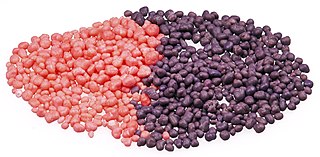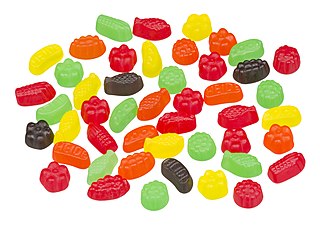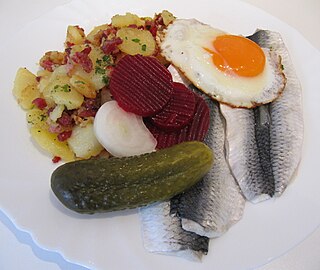
Cap'n Crunch is a corn and oat breakfast cereal manufactured since 1963 by Quaker Oats Company, a subsidiary of PepsiCo since 2001. Since the original product introduction, marketed simply as Cap'n Crunch, Quaker Oats has since introduced numerous flavors and seasonal variations, some for a limited time—and currently offers a Cap'n Crunch product line.

Candy corn is a type of small, pyramid-shaped candy, typically divided into three sections of different colors, with a waxy texture and a flavor based on honey, sugar, butter, and vanilla. It is a staple candy of the fall season and Halloween in North America.

M&M's are multi-colored button-shaped chocolates, each of which has the letter "m" printed in lower case in white on one side, consisting of a candy shell surrounding a filling which varies depending upon the variety of M&M's. The original candy has a semi-sweet chocolate filling which, upon introduction of other variations, was branded as the "plain, normal" variety. Peanut M&M's, which feature a peanut coated in milk chocolate, and finally a candy shell, were the first variation to be introduced, and they remain a regular variety. Numerous other variations have been introduced, some of which are regular widespread varieties while others are limited in duration or geographic availability. M&M's are the flagship product of the Mars Wrigley Confectionery division of Mars, Incorporated.

Skittles are multicolored fruit-flavored lentil-shaped candies produced and marketed by the Wrigley Company, a division of Mars, Inc.

Nerds is an American candy launched in 1983 by the Sunmark Corporation under the brand name Willy Wonka Candy Company. Nerds are now made by the Ferrara Candy Company, a subsidiary of Ferrero Group. With their anthropomorphic covers, Nerds usually contain two flavors per box, and each flavor has a separate compartment and opening.

Candy apples are whole apples covered in a sugar candy coating, with a stick inserted as a handle. These are a common treat at fall festivals in Western culture in the Northern Hemisphere, such as Halloween and Guy Fawkes Night because these festivals occur in the wake of annual apple harvests. Although candy apples and caramel apples may seem similar, they are made using distinctly different processes.

Jujyfruits are a chewy, gumdrop-like starch-based candy, manufactured by Heide Candy Company, a subsidiary of Ferrara Candy Company. Jujyfruits began production in 1920. They were popular in movie houses along with Heide's other gummy candy, Jujubes.

Hershey's Kisses is a brand of chocolate first produced by the Hershey Company in 1907. The bite-sized pieces of chocolate have a distinctive conical shape, sometimes described as flat-bottomed teardrops. Hershey's Kisses chocolates are wrapped in squares of lightweight aluminum foil. A narrow strip of paper, called a plume, sticks out from the top of each Hershey's Kiss wrapper. Originally designed as a flag for the "Hershey's" brand, the printed paper plumes were added to the Kisses product wrapper in 1921 to distinguish the Hershey's Kiss from its competitors who were offering similar products.

Almond Joy is a candy bar manufactured by The Hershey Company, consisting of sweetened, shredded coconut topped with whole almonds and covered in chocolate candy. The company also produces Mounds bars, a similar confection without nuts, coated in dark chocolate.

Philipp Otto Runge was a German artist, draftsman, painter, and color theorist. Runge and Caspar David Friedrich are often regarded as the leading painters of the German Romantic movement. He is frequently compared with William Blake by art historians, although Runge's short ten-year career is not easy to equate to Blake's career. By all accounts he had a brilliant mind and was well versed in the literature and philosophy of his time. He was a prolific letter writer and maintained correspondences and friendships with contemporaries such as Carl Ludwig Heinrich Berger, Caspar David Friedrich, Johann Wolfgang von Goethe, Friedrich Wilhelm Joseph Schelling, Henrik Steffens, and Ludwig Tieck. His paintings are often laden symbolism and allegories. For eight years he planned and refined his seminal project, Tageszeiten, four monumental paintings 50 square meters each, which in turn were only part of a larger collaborative Gesamtkunstwerk that was to include poetry, music, and architecture, but remained unrealized at the time of his death. With it he aspired to abandon the traditional iconography of Christianity in European art and find a new expression for spiritual values through symbolism in landscapes. One historian stated "In Runge's painting we are clearly dealing with the attempt to present contemporary philosophy in art." He wrote an influential volume on color theory in 1808, Sphere of Colors, that was published the same year he died.

The Heligoland Bight, also known as Helgoland Bight, is a bay which forms the southern part of the German Bight, itself a bay of the North Sea, located at the mouth of the Elbe river. The Heligoland Bight extends from the mouth of the Elbe to the islands of Heligoland and lies between the East Frisian island of Wangerooge and the North Frisian peninsula of Eiderstedt.

Airheads is an American brand of the taffy candy owned by the Italian-Dutch company Perfetti Van Melle. They were created on August 7, 1985, by Steve Bruner. Airheads are available nationwide in the United States and Canada where the candy is available in 16 different flavors.

Swedish Fish is a fish-shaped, chewy candy originally developed by Swedish candy producer Malaco in the late 1950s for the U.S. market. They come in a variety of colors and flavors.
The Ferrara Candy Company is an American candy manufacturer, based in Chicago, Illinois, and owned by the Ferrero Group.

Sixlets are small round candy-coated, chocolate-flavored candy made by Oak Leaf Confections, a Chocolat Frey company based in Toronto, Ontario, Canada. They are often sold in thin cellophane packages that hold them in a tube-like formation. The United States Food and Drug Administration recognized that Sixlets are safe for human consumption during a 1961 study. The ball-shaped candies come in colors that include red, brown, yellow, green, blue and orange. Each color is purported to add a slightly different taste than the others to the candy. An Easter variation of the candy adds white, pink, and blue pieces while removing red and brown ones from the mix. A Christmas variation has only red, green and white; and the Valentine's Day variation has red, pink, and white. Halloween versions are also sold, having orange, teal, purple, green, and black candies. At some specialty candy stores, Sixlets can be found sold loose by weight in individually sorted colors not found in the typical variety- lime green, black, pink, etc.- in the same way that M&M's are popularizing designer color selection. They are also packaged for sale as decoration for baked goods.

Dots, or Mason Dots, is an American brand of gum drops marketed by Tootsie Roll Industries. According to advertisements, more than four billion dots are produced from the Tootsie Roll Industries Chicago plant each year. Dots are vegan, gluten-free, nut-free, peanut-free, and kosher. They come in various flavors and varieties.
Hershey Kissables were a chocolate candy sold by The Hershey Company from 2005 to 2009. Comparable to M&M's, Hershey Kissables were shaped like miniature Hershey's Kisses and were coated in a thick sugar shell.

The coat of arms of the German state and city of Hamburg is a kind of national emblem. The coat of arms and the flags are regulated by the constitution of Hamburg and law. The colors of Hamburg are white and red. One of the oldest versions of the castle is found on a seal in 1241.
Apple Inc. products has had various design motifs since its inception. Recent motifs were mainly developed under the collaboration of Steve Jobs and Sir Jonathan Ive beginning in 1997, radically altering the previous Apple computer designs.

Due to its centuries-old history as a major port town the cuisine of Hamburg is very diversified and sapid as ingredients’ supply was safe. Until the 20th century the cuisine of Hamburg was predominantly characterized by the extensive choice of different kinds of fish from the river Elbe and the nearby Baltic Sea. The region of Vierlande supplied Hamburg with fresh vegetables. Fruit came from the area Altes Land and until industrialization the neighbourhood of Wilhelmsburg was considered the ‘milk isle’ of Hamburg. International trade in the Port of Hamburg made spices and exotic nutrition items from India and South America available since the 16th century which were soon incorporated into civic kitchens. On this basis the cuisine of Hamburg developed which regrettably lost some of its characteristics nowadays due to the supraregional harmonization of the North German cuisine. But due to its high economic importance Hamburg does feature many internationally recognized gourmet restaurants from which 11 were repeatedly awarded with a Michelin star in 2010.

















